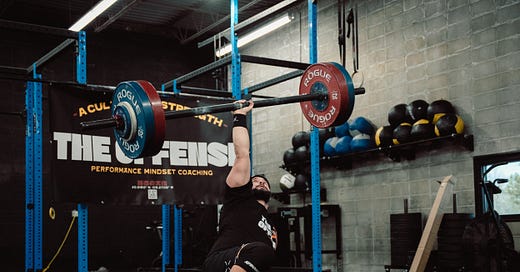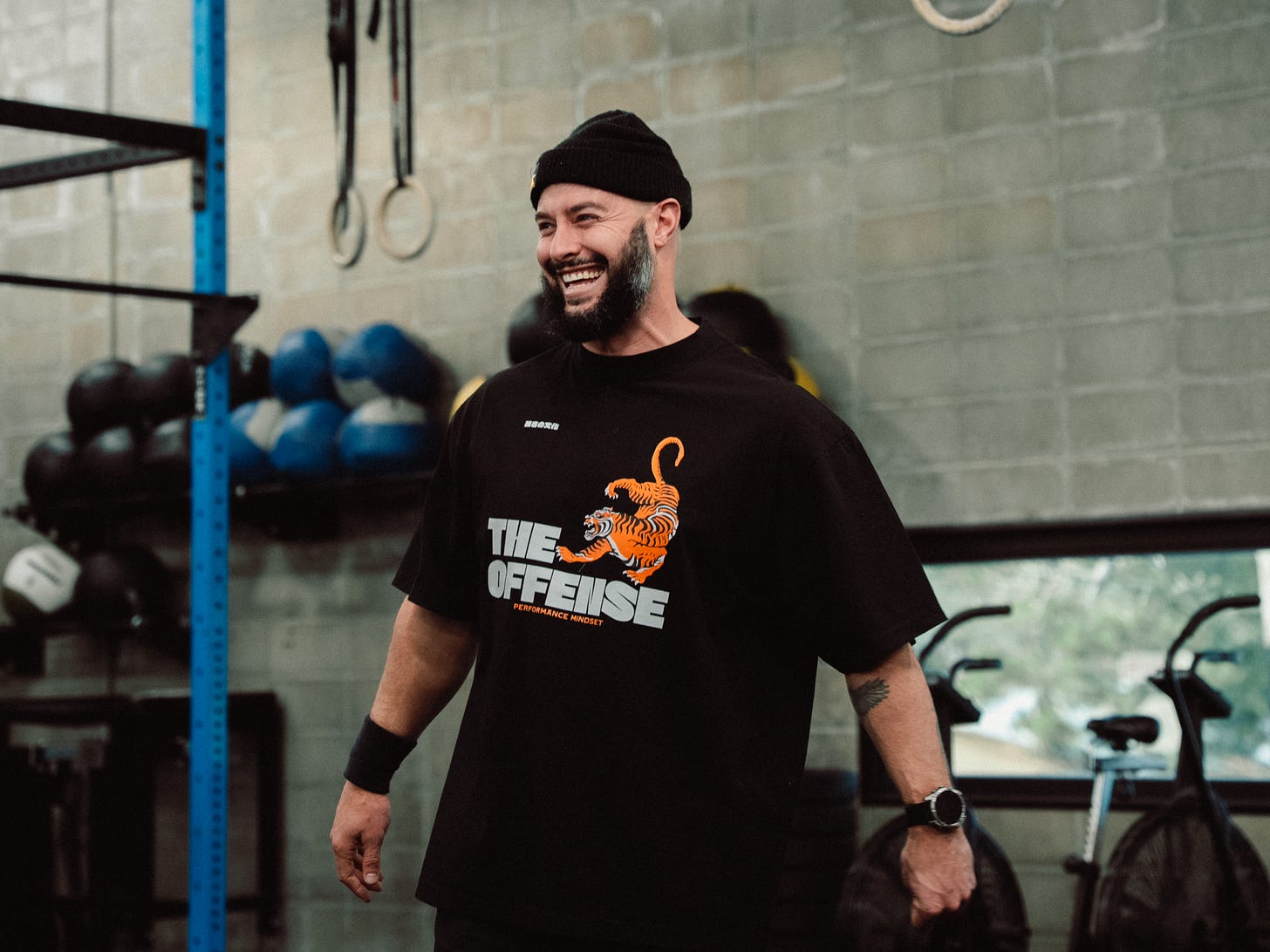Turkish Get-Up Tips from 2-Time World Record Holder
Mike Aidala knows a thing or five about the Turkish get-up.

Saturday, February 22, Mike Aidala took the floor at V23 Athletics, a mixed-modality training gym south of Denver, to attempt his second world record in the Turkish get-up. Three years earlier, the performance mindset coach achieved his first world record in the same place, moving more than 13,000 pounds in the form of heavy kettlebells over the course of one hour (a record that has since been broken).
This time, he was aiming for the heaviest single repetition of the movement that would break the standing Guinness World Record of 200 pounds. All the gym’s kettlebells were neatly shelved along the wall; instead, a thick axle barbell sat on the floor, waiting to be loaded up.
Aidala, who’s gained notoriety through his circus-style strongman stunts, knew he’d be able to set the new record. He’d already maxed out the lift in a training session at 245 pounds. But telling Guinness World Records you’ve done something isn’t enough. He needed official documentation: a Guinness-approved scale and video so officials could review and certify his attempt. That, along with raising awareness of Mission 22, an organization supporting veterans, was what the day’s event was for.
Caution tape roped off his lifting area, giving him ample room to warm up and drop lifts in the sights of spectators. His warmup didn’t take very long. He lifted the empty bar, working through all seven steps of the Turkish get-up and reversing them back down. Then, he did a rep or two with more weight. His first record-breaking attempt, 224.2 pounds, moved easily, and he took a quick break before attempting to max out the lift.
With the bar loaded to 255 pounds, he laid down, pulled the bar over his chest, benched it off the ground, and shifted his right hand to the center of the bar. His left hand let go, and Aidala proceeded into the rest of the get-up. It took him two attempts to successfully lift the weight. On his successful second attempt, he focused hard and fought to maintain balance all the way up and down. But he got it:
Shortly after he set the record, I interviewed Aidala to learn about how he trained ahead of time and what tips he’d share with other athletes. Here’s what he said:
1. Hand placement is everything when you use a barbell.
With a kettlebell, the weight falls to the back of your forearm and might shift a little through the movement, but when you use a barbell in the Turkish get-up, it’s like lifting a see-saw overhead.
“I have tape in the middle, so I know exactly where I want to put my hand,” Aidala says. “Some of the heavier attempts, I actually had my hand in the wrong spot, and the barbell would twist.”
The Turkish get-up already involves shifting your weight and center of balance. A twisting or lopsided barbell makes it even harder to manage those shifts: You might be able to get up to your elbow and your hand, but it will be harder to pull the weight back over as you move into the lunge.
“If your hand is four inches off-center, you’re going to be fighting it the entire time,” Aidala says. Put your hand in the right spot, roughly the center of the bar, and the movement won’t be easy, but it will be easier.
2. Keep your eyes on your hand.
Your whole body needs to be locked in the entire time you’re doing the get-up — and this includes your eyes. Keeping your eyes on your hand will help you hold the bar or kettlebell above you in a somewhat steady position, while also helping you move under the weight in a way that won’t send it flying in one direction or the other.
It’s as if a line is drawn from your hand to your eyes, and as you move through the get-up, that line extends through your shoulder, your arm, then your spine and leg, what Aidala refers to as columns. “You get to the shoulder, you’re on that column,” he says. “Then you get to the hand, you’re on that column.”
3. Train your sticking spots.
The two hardest parts of the Turkish get-up are shifting to the elbow and completing the lunge.
“If I can get to the elbow, I can most likely get to the lunge, and if I get up from the lunge, I can pretty much finish the lift,” Aidala says.
To train for his record, he focused on building maximum strength in his legs, arm, and wrist, and he drilled the different get-up positions — sometimes not even completing the full movement, just seeing how much weight he could move and still get onto his elbow or how much he could hold in one arm overhead. Exploring his limits in those positions helped him gain confidence in loading more weight for the full movement.
4. Know when to bail and give yourself plenty of space to do so.
There are a couple ideal times to bail out of the get-up: at the beginning, when you’re trying to get up to your elbow, and halfway through when you’re shifting into the lunge. In both cases, you’ll want to direct the weight in a particular direction depending on where it is above you.
The kettlebell is harder to bail because your hand is caught in it, so if possible, lower yourself down instead. If you’re using a barbell, push it in the direction it’s already falling — either forward or backward — and get yourself out of the way. Be sure to practice bailing with light weight before you load heavier weight. If you try to ego lift in the Turkish get-up, you won’t have an ego left.
Wherever you’re training, make sure you have plenty of room to throw the weight without it hitting anyone or anything. In his training, Aidala used large diameter wagon wheel plates to be safer, but 10-pound bumper plates are a good option once you’re comfortable with the empty bar.
5. To go heavy, train the get-down.
In the same vein as my tips for athletes chasing their first pullup or pushup, practicing the Turkish get-up in the opposite direction — that is, the direction of gravity — could help you on the way up.
For Aidala, this looked like loading the bar with 300 pounds, lifting it overhead on one arm, and proceeding to lunge down, put his opposite hand on the ground, slide to his elbow, and lay down. For the rest of us, this could simply mean grabbing a 25- or even 15-pound kettlebell and proceeding through the movement backwards.
Don’t be surprised if you get a little confused on the way down. It’s hard to remember all the steps of the Turkish get-up in the first place, and even Aidala got thrown off when he trained the get-downs. “I’m not used to starting at the top,” he said. But take your time and work through it.
Oh, and if you want to set the first female Guinness World Record for heaviest single repetition Turkish get-up, looks like there’s no current record holder so it could be yours. (Shout-out to Jaclyn Vazquez of West Bend, Wisconsin, for holding the female record for most weight lifted in one hour with the get-up.)
Recommended Reads
Ilona Maher and the sisterhood fueling a women’s sports trailblazer (The Athletic)
Menopause Is Having a Moment (The New Yorker)
What’s coming next?
More of the Injury Diaries.
P.S. If you listened to the voiceover, thanks for bearing with me.







Found you through th ILJ...like with lifting, in cooking hand placement is everything...let's keep in touch